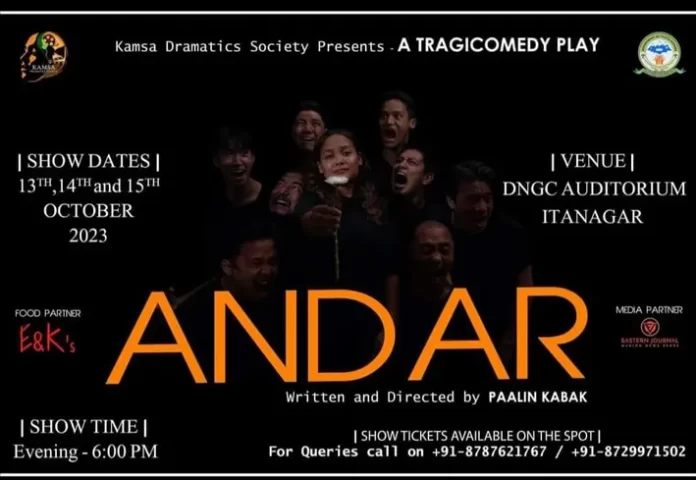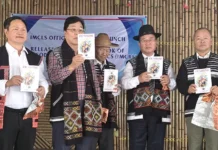[ Mukul Pathak ]
To tell a story about what people are already aware of on a stage in drama form is always a challenge. Accepting the challenge itself is another challenge.
After watching the drama ‘Andar’ on Friday evening at the Dera Natung Government College (DNGC) auditorium in Itanagar, I feel that the Kamsa Dramatics Society undertook both the challenges successfully. Written and directed by Paalin Kabak, every character in the drama depicted the role they were given to portray. The three-day drama performance started on 13 October and will end on 15 October.
The storyline is based on the hot topic of APPSC irregularities and its social impact, as well as the mindset of different sections of the people. A few persons of different occupations residing in a small colony are involved in the process of protest amidst their personal struggles of livelihood. An aspirant of APPSC exam who attempted thrice for a final selection in his
viva had a breakup with his long-time girlfriend. An autorickshaw driver having trouble with his autorickshaw, a street food vendor having problem with unpaid money by his known customer, an IRBn jawan, and another young mechanic plays the major roles. A union leader who skillfully motivated them to persuade their personal issues deep rooted with the government and staged a protest rally. This resulted in injuries to the protesters and the IRBn jawan. The aspirant denied an offer of cash-for-job from a family friend and finally failed in viva. And finally, the climax entered.
The writer successfully tried to find the causes of the present-day situation in Arunachal without taking sides. As a vigilant observer, Kabak developed the story and righteously turned the drama into tragicomedy, as he claimed on the promo poster. The acting of all the 10 characters did their best to do justice to their respective characters. The typical Arunachali style of delivery of words, expressions and reactions added important ingredients, making the drama a huge success.
Bole Dawe played the role of an aspirant and performed well. As a union leader, Kon Nitin reminded me of a few real-life union leaders of the state. His body language and dialogue delivery made him a very potential actor. Toko Telyi as an IRBN jawan and Likha Lijum as an autorickshaw driver proved their potential and talent as very promising actors.
But the most attractive part of the play was the spontaneous acting of Tassar Sonny as Magu in the play. There was hardly anyone in the auditorium who did not enjoy his act. The only female character in the play, Leepi, played by Bomju Riram, is very talented not only in acting but in dancing also. Though her character in the play was somehow restricted as a lover and victim of the system, she showcased her ability to portray the role at her best.
Three other characters – Marky Tadang, Sandeep Medhi and Sajan Ali – added much needed flavour in the drama. Sajan Ali, who is working at a local hotel in real life, impressed the audience with his sweet voice during his performance as a singer in the play, and proved that talent just needs a chance to prosper.
But there are a few aspects I personally feel that needed some attention. The ‘slap’ on the uncle’s face was so hard that even the actor must have been surprised and felt the pain. On stage, an act should look real, but it is always an act only. As an audience, I found it a little odd. The coffin used was much bigger than real sized ones and it is understandable that, to perform the opening scene, it was needed. Though the set design was excellent and bore a cinematic flavour, somehow it missed the dramatic touch.
Set designing is a crucial part of a drama, and here I feel that the main stage was very small, and the set designer was compelled to use the front spaces of the stage, reducing the space for the audience. It is always hard to perform just a couple of feet away from the audience sitting in the first row. For an amateur drama production house there are always budgetary hurdles and materials used as set property on the state reflects that it was expensive. It appears that the production team tried to give a true feel. But it is a delight to watch a drama in Itanagar, where hardly any dramas are staged.
In the past one year in Arunachal, young artists, play writers and actors are coming out to stage dramas in various places. Thanks to the state government for promoting local drama artists on a few occasions. But at the same time, I feel that there are still many things to address to build a strong presence of drama in the state. Almost all the capital cities in India have multiple auditoriums, which help the artists to perform their art and culture. But in Itanagar, apart from DK State Convention Centre, there is no state-of-the-art auditorium to stage a drama. Even the DK State Convention Centre has some restriction to improvise the stage as per requirement for a drama, not to mention about the rent of Rs 70,000 per day, which is impossible to pay by an amateur drama group. The principal of DNGC deserves appreciation for allowing the college hall to stage the drama. The other auditoriums in the city are just halls with maximum echo and less infrastructure. The state also organises a film festival every year, but due to shortage of quality auditorium, it fails to attract audiences. After watching the drama, I am sure that the young artists who are coming out with their zeal and passion to showcase the cultural and social aspects of the state in art form, it is just a beginning and has the potential to become the voice of the people in coming years.
Three cheers for the Kamsa Dramatics Society for presenting a beautiful drama. (The contributor is reporter and general secretary, Arunachal Pradesh Literary Society)





